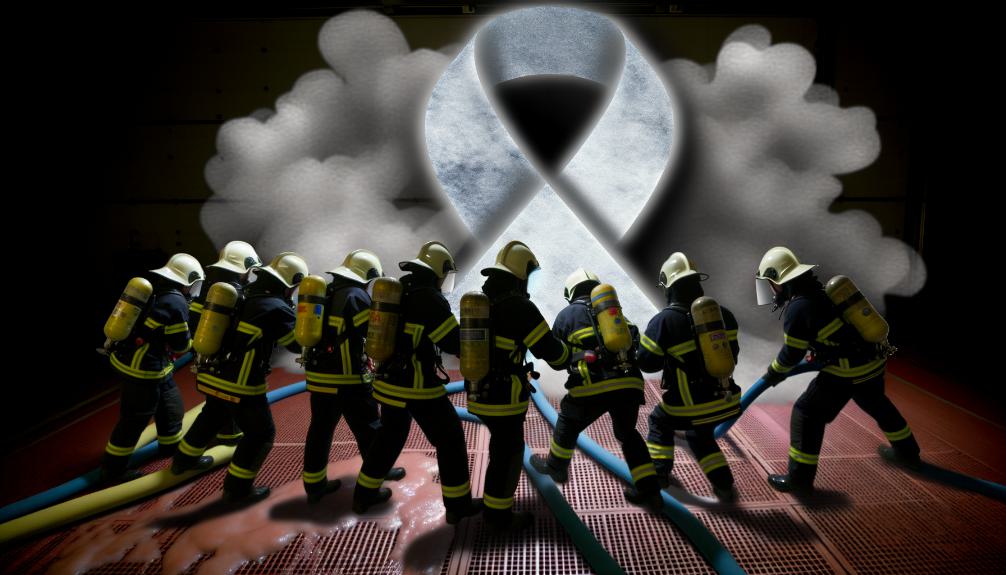Risk Factors for Testicular Cancer in AFFF Lawsuits
We've discovered that exposure to Aqueous Film Forming Foam (AFFF), particularly its PFAS chemicals like PFOA and PFOS, greatly raises the risk of testicular cancer. This danger prominently impacts firefighters and military personnel, who are more frequently exposed due to their professions. Numerous lawsuits underline a strong correlation between AFFF exposure and heightened testicular cancer risk, arguing negligence in warning of the risks. These legal battles are pushing for accountability and substantial changes in safety protocols. With every case that comes to light, the understanding of these risks grows, hinting at a deeper exploration into protective measures and legal rights.

Key Takeaways
- AFFF contains PFAS chemicals, notably PFOA and PFOS, strongly linked to increased testicular cancer risk.
- Firefighters and military personnel are at higher risk due to prolonged exposure to AFFF in their line of work.
- Exposure duration to AFFF significantly influences the risk, with long-term exposure raising the chances of developing testicular cancer.
- Over 700 military bases have reported PFAS contamination, highlighting widespread exposure among military personnel.
- Protective gear currently used does not fully prevent PFAS exposure, underscoring the need for improved safety measures.
Understanding AFFF Exposure

To fully comprehend why we're observing more testicular cancer cases in certain professions, it is crucial to understand what AFFF exposure entails. Aqueous Film-Forming Foam, or AFFF, has been widely utilized by firefighters and military personnel for extinguishing fuel fires. However, this seemingly advantageous agent harbors dangerous PFAS chemicals which do not degrade, posing long-term health risks.
The connection between AFFF exposure and an increased risk of testicular cancer has become increasingly evident. Studies have highlighted that those in contact with AFFF, especially firefighters and military personnel, face higher chances of developing this malignancy. This is primarily due to the PFAS chemicals contained in AFFF, which have been identified as significant risk factors for testicular cancer.
Understanding the history of AFFF exposure is critical, particularly within the context of lawsuits. Identifying and establishing these risk factors is essential in proving the correlation between AFFF exposure and the development of testicular cancer. It's not just about acknowledging that these chemicals are harmful; it's about recognizing the specific dangers they pose to those who have served as our first line of defense against fires and in military operations.
Our focus on this issue arises from a commitment to illuminate the hidden dangers these heroes face. By delving into the specifics of AFFF exposure, we aim to contribute to a broader understanding of the risk factors linked to testicular cancer, emphasizing the need for protective measures and policy changes to safeguard our firefighters and military personnel from such significant health risks.
PFAS Chemicals and Health
We're now shifting our attention to the health implications of PFAS exposure, particularly in relation to testicular cancer. It's essential to understand how PFAS, with their long-lasting presence in the environment, may pose significant health risks. Our analysis will cover the overview of these risks and the impact of PFAS on health, offering insights into the complexities of these legal cases.
PFAS Exposure Risks
Amid mounting concerns, it's evident that exposure to PFAS chemicals, particularly PFOA, significantly escalates the risk of developing testicular cancer. These substances, central to AFFF lawsuits, have been associated through studies indicating a substantial connection. It's concerning how PFAS chemicals like PFOA, infamous for their persistence in the environment, pose long-term health risks. They don't degrade easily, accumulating in soil and air, especially near industrial sites known for utilizing or disposing of these compounds. Moreover, recent research illuminating how PFAS can disrupt hormone balance sheds light on the potential mechanisms propelling the increased risk of testicular cancer. It's essential that we grasp the gravity of PFAS exposure as part of the broader conversation on health risks in AFFF lawsuits.
Health Impacts Overview
Having established the relationship between PFAS exposure and testicular cancer, let's now explore the broader health impacts of these chemicals. PFAS, particularly PFOA, is not only linked to testicular cancer but also to kidney and prostate cancer. These chemicals mimic human hormones, such as thyroid, estrogen, and testosterone, disrupting our body's natural functions. Exposure is most common near industrial areas where PFAS are manufactured, affecting soil and outdoor air. For military servicemen, the stakes are even higher, given the widespread use of AFFF (aqueous film-forming foam) in training and firefighting, leading to heightened PFAS exposure. These health impacts are at the core of AFFF lawsuits, spotlighting the urgent need for accountability and regulation.
PFOAs Strong Cancer Link
PFOA's connection to testicular cancer emerges as the most alarming among PFAS chemicals, underscoring the urgent need for awareness and action. This revelation is particularly concerning, given the persistent nature of PFAS chemicals, including PFOA, which do not break down easily and accumulate in the environment. The proximity to industrial areas where PFAS manufacturing or use is prevalent poses a significant risk, exposing populations to PFOA and elevating the potential for developing testicular cancer.
Studies have indicated a plausible connection between PFOA exposure and an increased risk of this disease, highlighting the chemical's potent ability to disrupt the body's natural functions. Importantly, recent research has shed light on how PFAS chemicals, such as PFOA, can mimic human hormones. This mimicry may play an important role in impacting hormone-related cancers, including testicular cancer, thereby pointing to a mechanism through which PFOA exerts its carcinogenic effects.
The strong link between PFOA and testicular cancer necessitates urgent action and further investigation. Individuals residing near industrial areas must be made aware of the risks associated with PFAS exposure, particularly PFOA. Additionally, the insights garnered from these studies are invaluable for legal professionals dealing with AFFF lawsuits, providing a foundational understanding of the chemical properties and health risks of PFOA. As we continue to uncover the extent of PFOA's impact on health, particularly regarding hormone-related cancers, it is imperative that we advocate for stricter regulations and measures to protect public health and hold responsible parties accountable for their role in this emerging health crisis.
PFOS Connection to Illness
We've discovered that PFOS, another perilous PFAS chemical prevalent in AFFF, is strongly linked to various illnesses, especially testicular cancer. This connection between PFOS exposure and the increased risk of developing testicular cancer is of significant concern, particularly for those with significant contact with AFFF firefighting foam. Research underscores a significant link, suggesting that individuals exposed to PFOS through AFFF are at a heightened risk.
The implications are particularly alarming for military personnel and firefighters who have historically used AFFF in their line of duty. The contamination from PFOS in AFFF has raised red flags about its role in escalating rates of testicular cancer within these groups. Studies have specifically pinpointed the detrimental effects of PFOS, a common element in AFFF, on the prevalence of testicular cancer. This points to a need for stringent measures to mitigate exposure and safeguard those at risk.
Understanding the connection between PFOS and illnesses such as testicular cancer is important for those exposed to AFFF. The findings underscore the urgency of addressing PFOS contamination and implementing protective strategies for vulnerable populations, especially military personnel. As we explore further into the harmful impacts of PFOS, it becomes increasingly clear that thorough action is necessary to combat its effects and provide relief to those affected. This encompasses both preventive measures and legal recourse for those who've suffered due to PFOS exposure, marking a critical step in addressing this public health concern.
Firefighters Increased Risk

We're now turning our attention to the heightened risk firefighters face due to AFFF exposure, specifically looking at exposure duration and the efficacy of protective gear. It's imperative to understand that the longer firefighters are exposed to PFAS through AFFF, the greater their risk for developing testicular cancer. Additionally, we'll examine how effective current protective gear is in mitigating these risks, a vital factor in protecting our frontline heroes.
AFFF Exposure Duration
The duration of a firefighter's exposure to AFFF, a foam containing harmful PFAS, greatly increases their risk of developing testicular cancer. We've observed that firefighters with long-term exposure to these AFFF chemicals are more susceptible to testicular cancer, highlighting how critical evaluating their risk. Prolonged exposure exacerbates the danger, with studies confirming that the length of time our firefighters handle AFFF directly impacts their risk levels. This connection between exposure duration and increased testicular cancer risk among firefighters underscores the urgency in addressing the health implications of AFFF chemicals. It's clear that prolonged exposure to AFFF is a significant factor in the heightened risk of developing testicular cancer for firefighters.
Protective Gear Efficacy
Despite advancements in protective gear, firefighters still face a significant risk of testicular cancer due to exposure to PFAS in AFFF. Our review of the current situation reveals that the protective gear efficacy is not absolute. Firefighters' direct contact with AFFF during operations, coupled with the inhalation and skin absorption of PFAS, escalates their risk. Despite adhering to safety protocols, unavoidable PFAS exposure during emergency responses is concerning. The reality is, the cumulative exposure to these chemicals places firefighters at a markedly higher risk of developing testicular cancer compared to the general population. It's clear that while protective gear provides a line of defense, it's not entirely foolproof against PFAS exposure in AFFF, underscoring a critical area for improvement.
Military Base Contaminations
Numerous military bases worldwide, over 700 in fact, have been identified with PFAS contamination due to AFFF usage, posing significant health risks to military personnel stationed at these locations. This widespread contamination has sparked concern and increased scrutiny over the safety and health of those who've served on these bases. The presence of PFAS, a group of chemicals known for their persistence in the environment and in the human body, has been directly linked to an elevated risk of testicular cancer among military personnel. This alarming connection has underscored the urgency of addressing PFAS exposure on military bases as an essential public health issue.
The Department of Defense has taken significant steps to assess and mitigate the impact of PFAS contamination across over 700 military installations. This proactive approach is pivotal in safeguarding the health of service members and supporting personnel. Additionally, the findings from various studies have strengthened the cases in AFFF lawsuits, highlighting the association between PFAS exposure and the development of testicular cancer. These lawsuits not only seek justice for affected individuals but also aim to hold manufacturers accountable for the health repercussions of their products.
As we explore further into the complexities of military base contaminations and their implications for service members' health, it's evident that addressing PFAS exposure is not just a legal issue but a moral imperative. The ongoing efforts by the Department of Defense, coupled with the legal battles against PFAS manufacturers, are essential steps in confronting this health crisis and ensuring the well-being of our military personnel.
AFFF Use in the Military

We're now turning our attention to the specific ways in which AFFF has been used within the military, focusing on training practices, exposure levels, and health monitoring protocols. Given its widespread use since the 1960s, understanding these factors is essential for evaluating the risk it poses to military personnel. Our analysis will highlight how these practices have potentially contributed to higher cancer rates among exposed service members.
Military Training Practices
The widespread adoption of AFFF in military training since the 1960s has exposed service members to significant health risks. This firefighting foam, containing PFAS, has been a staple in military exercises, designed to simulate real-life firefighting scenarios. Unfortunately, the regular use of AFFF by military personnel has led to increased PFAS exposure, raising serious health concerns. The Department of Defense (DOD) recognizes these risks and has plans to phase out AFFFs by 2024. However, the damage may already be extensive, as AFFF seepage at military bases has created PFAS pollution hotspots. With thousands of military sites in the US affected by PFAS contamination from AFFF use, the urgency to address these concerns is paramount.
AFFF Exposure Levels
Understanding the level of AFFF exposure among military personnel is key to comprehending the health risks they face. Since the 1960s, the use of AFFF containing PFAS by the US military has led to significant PFAS contamination across over 700 global military bases. This widespread use and the resulting contamination have heightened concerns about the potential link between AFFF exposure levels and an increased risk of testicular cancer among military personnel. It's important to emphasize that firefighters with AFFF exposure have exhibited higher cancer rates, underscoring the urgency in addressing this issue. As we move towards the DOD's 2024 phase-out of AFFFs due to these health concerns, the focus on understanding and mitigating exposure levels remains paramount in safeguarding our military personnel's health.
Health Monitoring Protocols
In response to the significant health risks posed by AFFF exposure, it's important that military protocols include thorough health monitoring for personnel potentially affected. The military's use of AFFF containing harmful PFAS since the 1960s necessitates the establishment of detailed health monitoring protocols. These protocols are essential in tracking any health issues, particularly the increased risk of testicular cancer linked to PFAS exposure. For military personnel who've had AFFF exposure, specific health measures are essential for the early detection and intervention of testicular cancer. By prioritizing early detection, we're taking a proactive stance against the risks posed by AFFF. Establishing these detailed health monitoring protocols is a necessary step in safeguarding our military personnel from the adverse effects of AFFF exposure.
Testicular Cancer Misdiagnosis

Misdiagnosing testicular cancer can greatly delay the urgent care patients need, often due to its symptoms mirroring less severe conditions. The rarity of testicular cancer, coupled with its symptom overlap with other less serious issues, such as epididymitis, can lead to misdiagnosis. This misstep in diagnosis hinders the timely initiation of proper treatment, negatively impacting the prognosis for those affected. It's not uncommon for symptoms like lumps or pain in the testicular area, which are indicative of testicular cancer, to be mistaken for benign conditions. This misinterpretation can cause significant delays in receiving the correct diagnosis.
To combat this issue, medical professionals rely on a combination of imaging tests, blood tests, and biopsies. These diagnostic tools are essential in confirming the presence of testicular cancer, aiding in the differentiation from other conditions that present similar symptoms. The use of these tools is critical in avoiding misdiagnosis, ensuring that patients receive the appropriate care promptly.
In the context of AFFF lawsuits, the awareness of the risk of misdiagnosis is essential for early detection and effective management of testicular cancer. Understanding that symptoms may not always point directly to the most severe condition is key in seeking and receiving the correct diagnostic tests. It's imperative that both patients and healthcare providers remain vigilant about the potential for misdiagnosis, as early and accurate diagnosis is paramount in improving outcomes for those diagnosed with testicular cancer.
Legal Support for Victims
Victims of testicular cancer due to AFFF exposure can seek legal support to pursue compensation, holding manufacturers accountable for their health issues. When exposed to PFAS, a group of chemicals found in AFFF, individuals face an increased risk of developing testicular cancer. The legal landscape surrounding these cases is intricate, yet there are legal experts dedicated to assisting victims through this complex process.
Our collective understanding of the risks associated with AFFF exposure has greatly evolved, prompting a surge in lawsuits aimed at securing justice for affected individuals. Legal support in these cases is not just about pursuing compensation; it's about understanding one's rights and the broader implications of PFAS exposure. Victims are often faced with substantial medical expenses, lost wages, and other damages stemming from their illness. Legal assistance can help pinpoint potential avenues for compensation, ensuring that victims are not left to bear the financial burden of their conditions alone.
Navigating the legal process can be challenging for those affected by testicular cancer from AFFF exposure. However, with the right legal support, victims can explore various compensation options. This includes potential settlements or awards that reflect the severity of their condition and the impact it has had on their lives. Legal teams specializing in AFFF lawsuits are equipped to guide victims through every step, from filing a claim to representing their interests in court.
In seeking legal support, victims take an important step towards holding manufacturers accountable and shedding light on the dangers of PFAS exposure. It's about more than compensation; it's about ensuring justice is served and preventing future harm.
Product Liability Considerations

Regarding AFFF lawsuits, product liability considerations are crucial for holding manufacturers accountable for the harmful effects of their firefighting foams. These legal actions focus squarely on the defects present in the foam, particularly those containing PFAS chemicals, which have been linked to an increased risk of testicular cancer. It's important to understand that these lawsuits target the negligence of companies in producing and selling firefighting foams without adequate warnings or safer designs.
The core of our argument in these cases revolves around the design defects and the insufficient warnings provided on AFFF products. We're not just talking about minor oversights; these are significant failures to protect consumers and end-users from the known risks associated with PFAS exposure. By bringing these issues to light, we aim to secure compensation for individuals who've suffered medical expenses and other damages due to this exposure.
We've seen firsthand how PFAS chemicals in firefighting foam can wreak havoc on lives, and it's our mission to hold those responsible accountable. Through product liability claims, we're not only seeking justice for those affected but also pushing for changes that will guarantee safer products in the future. The fight in AFFF lawsuits is a challenging one, but it's a battle we're committed to, for the sake of our clients and the wider community. As we continue to uncover more about the dangers of PFAS and its link to testicular cancer, our resolve only strengthens to make sure such negligence is not repeated.
Symptoms of Exposure
After exploring the legal implications tied to AFFF's harmful effects, we must also address the physical symptoms individuals may experience due to exposure, including those linked to testicular cancer. It's important to recognize that symptoms of exposure to AFFF chemicals can manifest distinctly, often signaling an underlying issue such as testicular cancer. Importantly, individuals exposed to AFFF may notice swelling, lumps, and alterations in the size or shape of the testicles. These symptoms are significant and warrant immediate medical attention.
Moreover, discomfort in the scrotum, a sensation of heaviness, and a dull ache in the lower abdomen are symptoms that cannot be overlooked. The presence of these symptoms, especially when experienced concurrently, might suggest an adverse effect from AFFF exposure. Sudden swelling in the scrotum and abnormal cells in the testicle also rank as potential indicators of testicular cancer resulting from AFFF contact. It's essential for individuals who have been exposed to AFFF and exhibit these symptoms to seek professional health evaluations.
Testicular cancer tied to AFFF exposure often presents with a lump in either testicle, which may be accompanied by sudden swelling in the scrotum. Recognizing these symptoms early is important for addressing the health implications of AFFF exposure. As we investigate this topic, it's clear that understanding the symptoms linked to AFFF exposure is crucial for those affected. It not only aids in legal pursuits but also in prioritizing one's health and well-being in the face of potential testicular cancer.
Prevention and Early Detection

To safeguard against the repercussions of AFFF exposure, it's important to prioritize prevention and early detection strategies, including regular self-exams and awareness of testicular cancer symptoms. These proactive steps can greatly enhance the chances of catching the disease at an early, more treatable stage. By conducting regular self-exams, individuals can become familiar with the normal feel of their testicles, making it easier to detect any unusual changes or lumps that warrant a medical evaluation.
Awareness of the potential risk factors, including exposure to Aqueous Film Forming Foam (AFFF), is vital. Military personnel, who may have been exposed to AFFF, should be particularly vigilant and undergo routine screenings for testicular cancer as part of their health monitoring protocols. It's not just about the immediate aftermath of exposure but understanding one's PFAS exposure history and its potential long-term health implications.
Prompt medical evaluation cannot be overstated. If symptoms or irregularities are observed during self-exams, seeking medical advice promptly ensures that any necessary diagnostic tests, such as ultrasounds or blood tests for tumor markers, can be conducted without delay. This swift action can lead to an early diagnosis, which is linked to greatly improved survival rates for testicular cancer.
In essence, regular self-exams, increased awareness of symptoms, and routine screenings form the cornerstone of effective prevention and early detection strategies. Coupled with a thorough medical evaluation in the event of suspected exposure or symptoms, these measures can greatly mitigate the risk and impact of testicular cancer following AFFF exposure.
Servicemembers Legal Rights
What rights do we have as servicemembers exposed to AFFF containing PFAS, especially when facing testicular cancer as a consequence? We're entitled to seek compensation for the harm suffered due to AFFF exposure during our military service. This is a critical concern for many of us who've bravely served, only to find ourselves battling a serious health condition linked directly to our duty.
Federal laws protect our rights to pursue claims against manufacturers of AFFF linked to testicular cancer. This means we're not alone in this fight; legal assistance is readily available to help us navigate the complexities of these claims. It's essential we comprehend our legal options and the benefits of seeking professional guidance.
For those of us diagnosed with testicular cancer attributed to AFFF exposure, we may also be eligible for disability compensation and medical benefits. These benefits are designed to provide financial relief and support during what is undoubtedly a challenging time. The process of claiming these benefits, while potentially intimidating, is made more manageable with the right support and advice.
Understanding our legal rights and the available pathways for compensation is the first step towards achieving some measure of justice. It's about more than just financial compensation; it's about recognizing the sacrifices we've made and the impact on our health. We deserve to have our cases heard and to receive the support necessary to navigate this difficult period. Our service should not lead to suffering in silence, especially when avenues exist to help us seek redress and compensation.

This post has been generated by AI and was not reviewed by editors. This is Not legal advice. Please consult with an attorney.



